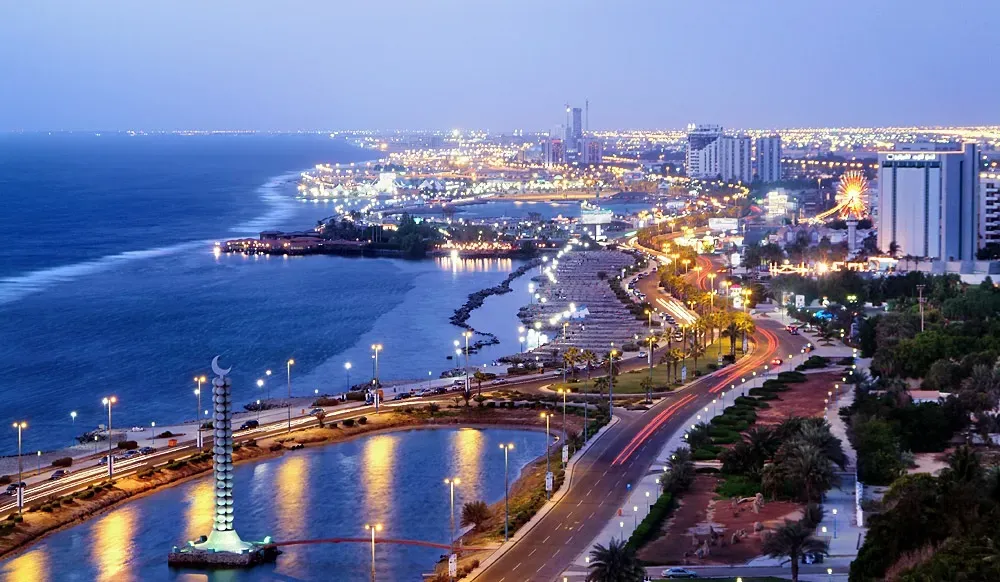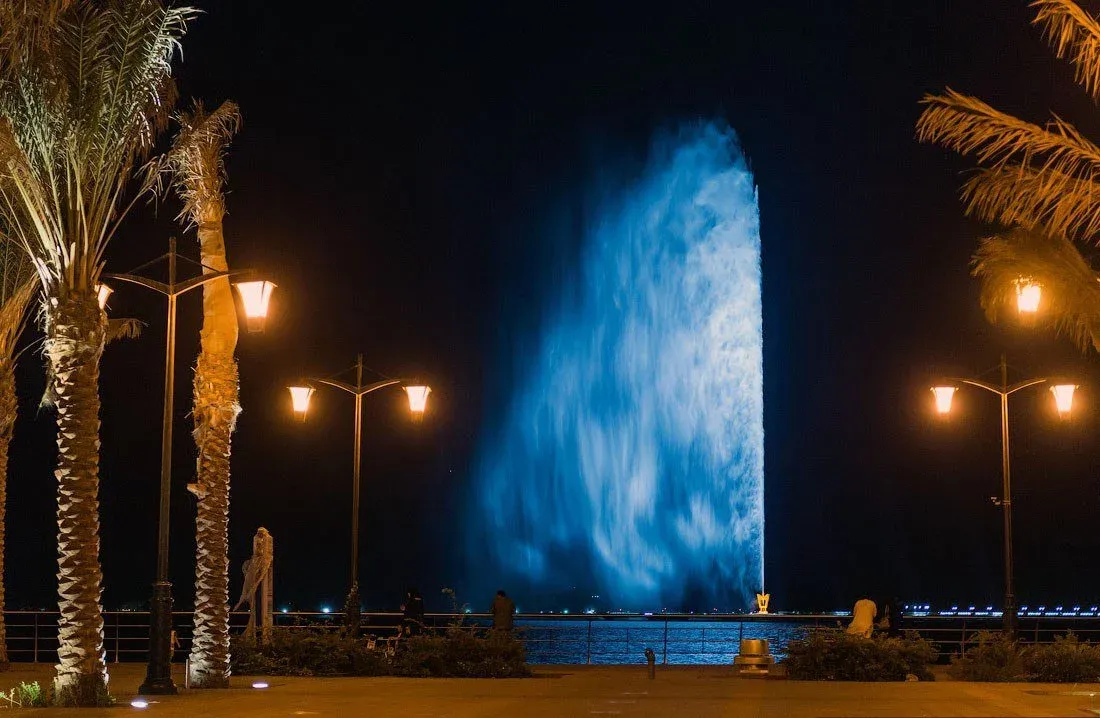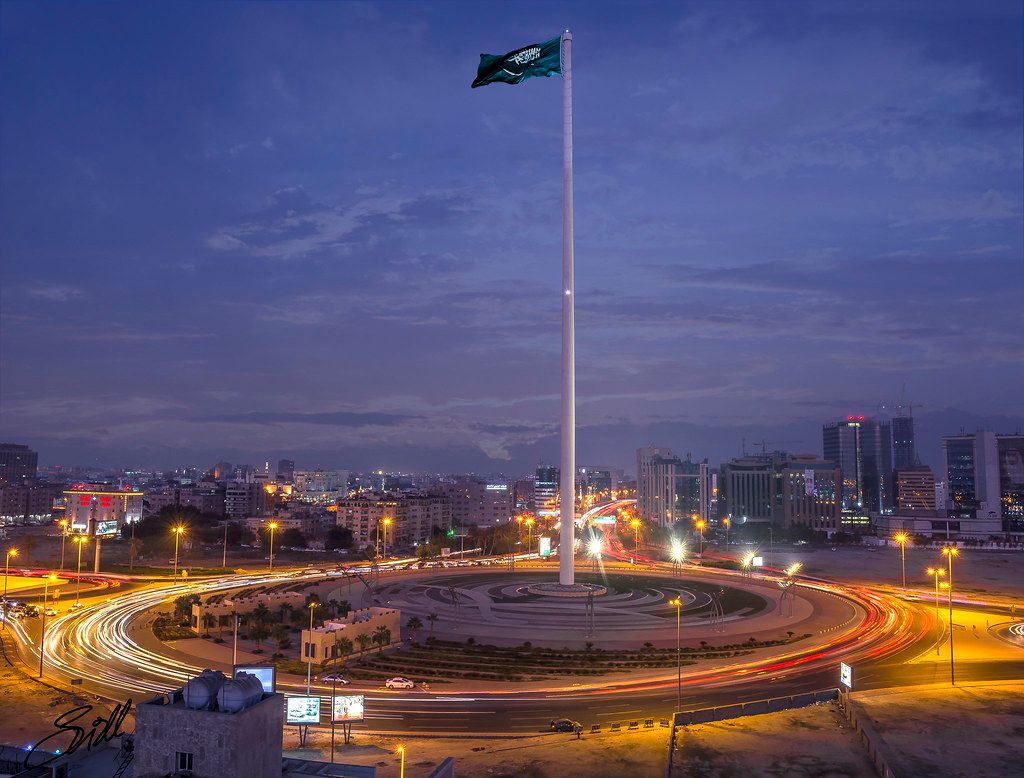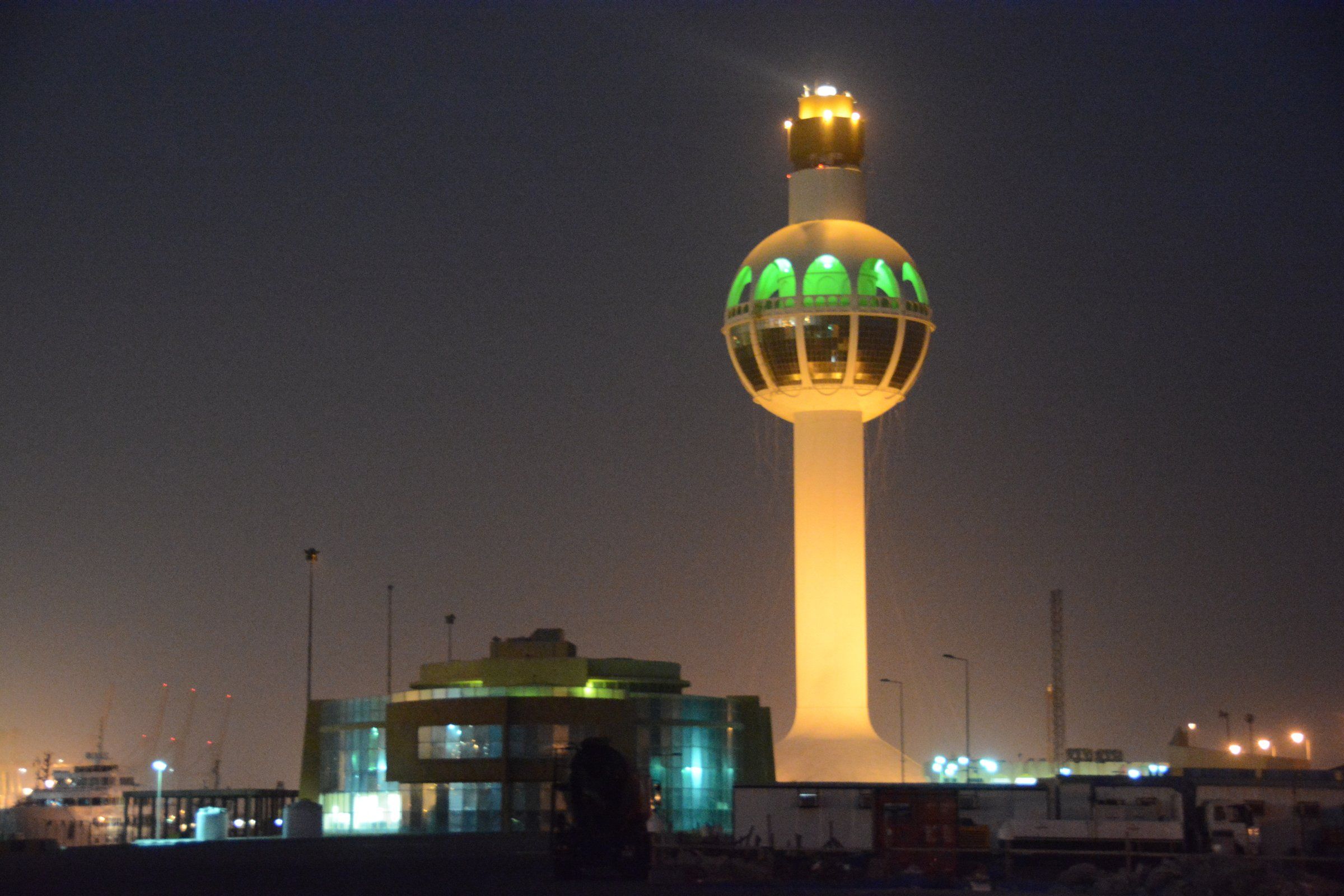
Jeddah is located along the Red Sea coast in the Hejaz region of Makkah Province, Saudi Arabia. Serving as the commercial hub of the country, Jeddah gained significance in 647 when Caliph Uthman designated it as a crucial travel hub for Muslim pilgrims en route to the holy city of Mecca.
As of 2022, Jeddah stands as the largest city in Makkah Province and the second largest in Saudi Arabia, with a metropolitan population of approximately 4,943,000 people. It holds strategic importance as the principal gateway to Mecca Sharif, the holiest city in Islam. Jeddah's thriving economic landscape focuses on capital investment in scientific and engineering leadership, positioning itself as a key player in Saudi Arabia and the Middle East. The city's Jeddah Islamic Port ranks among the world's largest and busiest seaports, contributing to its status as a significant economic center.

Beyond its economic significance, Jeddah serves as one of Saudi Arabia's primary resort cities, earning recognition as a Beta world city by the Globalization and World Cities Study Group and Network (GaWC). The city's unique food culture, dominated by fishing and seafood due to its proximity to the Red Sea, sets it apart. Embracing its distinctiveness, Jeddah's city motto in Arabic is "Jeddah Ghair," translating to “Jeddah is different”.
Jeddah has about 30 kilometers of coastal area along the Red Sea, with a notable waterfront project named "Jeddah Waterfront". This area, refurbished in 2018 at a cost of SR800 million, spans over 4 kilometers near Al-Nawras Square. The waterfront features water-sport parks, beaches, children's play areas, interactive water fountains, restaurants, kiosks, a floating marina dock, sculptures, restrooms, and phone charging stations. This development enhances the city's recreational offerings and provides a picturesque setting for locals and tourists.
Gifted to the people of Jeddah by King Fahd in 1985, the King Fahd Fountain is an iconic landmark visible throughout the city. Reputed as the world's tallest fountain, its water jets reach heights varying between 260 meters (853 feet) and 312 meters (1,024 feet) above the Red Sea. This structure adds to Jeddah's skyline and serves as a symbol of King Fahd's contribution to the city's cultural and architectural landscape.

Built in 1985 above the Red Sea, Al-Rahmah Mosque, often referred to as the "Floating Mosque," presents a unique architectural marvel. Located at the edge of the Jeddah Corniche, this mosque appears to float during high tide, providing a stunning visual spectacle. Combining modern amenities with traditional Islamic architecture, the mosque is a famous tourist spot, drawing visitors to witness its beauty during sunrise or sunset.
Balad, one of the oldest areas in Jeddah, earned UNESCO World Heritage Site status in 2014 due to its historical buildings and cultural significance. With some structures surpassing 100 years in age, Balad preserves the city's heritage. Despite modernisation, Balad remains a vibrant area, attracting crowds, especially during Ramadan. The district is also renowned for its markets and bazaars, making it a popular destination for shopping.
Established in 2013, Fakieh Aquarium stands as the only public aquarium in Saudi Arabia, offering visitors a glimpse into the marine world. Housing over 200 species, including sharks, groupers, stingrays, dolphins, and seahorses, the aquarium provides an educational and entertaining experience.
Completed in 2014, the Jeddah Flagpole is the world's tallest flagpole, soaring to a height of 171 meters. Located in King Abdullah Square, it symbolizes national pride, particularly during Saudi Arabia's National Day celebrations. The flagpole proudly hoists a Saudi Arabian flag measuring 49.5 meters by 33 meters, weighing 570 kilograms.

Proposed by billionaire investor Prince Alwaleed Bin Talal, the Jeddah Tower is a part of Jeddah Economic City Project. Upon completion, it will be the world's tallest building, reaching over 3,281 feet or 1,000 meters.
The Jeddah Lighthouse, situated on the north side of the Jeddah Islamic Seaport, holds the title of the world's tallest lighthouse. Standing at 133 meters (436 feet), this active lighthouse surpasses others in structural height, as recognised by the Guinness World Records.

Featuring a 50-foot metal sculpture of a bicycle, the Bicycle Square near King Fahd Road stands out as a unique art installation in Jeddah. Installed in 1982, this sculpture, also known as Midan Addarajah, is an eye-catching landmark, allowing visitors to appreciate the artwork up close and capture memorable pictures.
Located at the intersection of Assalam Street and King Abdul Aziz Road, the Globe Roundabout is a prominent tourist attraction in Jeddah. Adorned with Saudi Arabian flags, the giant metal globe in the middle of the intersection lights up at night, displaying the map of the world. Designed by the Spanish architect Julio Lafuente, this globe, along with other large art installations, adds an artistic touch to Jeddah's urban landscape.
Jeddah's history traces back over 2,500 years, with evidence of early Thamudic inscriptions and the presence of inhabitants before Alexander the Great. Initially a fishing hamlet founded by the Yemeni Quda'a tribe around 115 BC, Jeddah gained prominence under the third Muslim Caliph, Uthman Ibn Affan, in 647 AD. It became a crucial port for Mecca, replacing Al Shoaib port southwest of Mecca. Over time, Jeddah evolved into the main city of the historic Hijaz province, serving as a vital harbor for pilgrims arriving by sea for the Hajj pilgrimage.
Under various Islamic dynasties, including the Fatimids, Ayyubids, and Mamluks, Jeddah thrived as a trade hub. The Fatimids, who took control in 969 AD, established extensive trade networks through the Red Sea, reaching China and the Indian Ocean. Ayyubid conquests in 1177 brought Jeddah into their empire, ushering in an era of economic prosperity and intellectual activity. Subsequently, the Mamluks took control in 1254.
In 1517, the Ottoman Turks conquered Jeddah, fortifying it against Portuguese attacks and making it an integral part of the Ottoman Empire. The Ottomans reconstructed Jeddah's walls in 1525 and maintained control until World War I. During this time, Jeddah endured attacks, including a two-day bombardment by the British frigate HMS Cyclops in 1858 in response to rioting.
In 1802, Nejdi forces captured Jeddah, but it was later retaken by Muhammad Ali Pasha in 1813. The Ottomans, with the help of Egyptian forces, regained control. The Ottoman Turks remained in power until the early 20th century.
During World War I, Sharif Hussein bin Ali led a revolt against the Ottoman Empire, declaring the Kingdom of Hejaz with Jeddah as a key city. Following internal conflicts, including a war with Ibn Saud, Jeddah eventually came under Saudi control in 1925.
In 1925, Ibn Saud, founder of the Kingdom of Saudi Arabia, captured Jeddah, marking the city's integration into the newly formed kingdom. Over the years, Jeddah experienced modernisation and expansion beyond its historical boundaries. The old city walls were demolished in 1947, and a preservation effort was initiated in 1990 to protect its heritage. In recent years, urban development projects, such as the Jeddah Central Project, have aimed at revitalising the city under Saudi Vision 2030, although facing controversy over mass demolitions and evictions.
Jeddah, a significant city in Saudi Arabia, functions within the framework of the country's administrative hierarchy. The Kingdom of Saudi Arabia is divided into 13 administrative provinces, known as "Emirates" or "Regions," and Jeddah is part of the Makkah Region (also known as the Mecca Region). The Makkah Region serves as an administrative division with its capital in Mecca, encompassing various cities, including Jeddah. Each region is overseen by a governor appointed by the King, responsible for implementing government policies and ensuring the region's socio-economic development.
Jeddah itself has a local governance structure to manage municipal affairs. The city has a mayor who oversees the day-to-day administration and development initiatives. The mayor is appointed by higher authorities and plays a crucial role in addressing the city's unique needs, coordinating public services, and fostering urban development. The municipal administration focuses on areas such as infrastructure, public services, and urban planning to meet the growing demands of Jeddah's population.
In recent years, Jeddah has witnessed various development projects aligned with the broader Saudi Vision 2030, an ambitious initiative aimed at diversifying the country's economy and enhancing its cities' infrastructure and services. The administration in Jeddah actively participates in implementing Vision 2030 goals, focusing on areas like urban planning, transportation, education, and tourism. This involves collaboration with various government entities, private sector stakeholders, and international partners to ensure comprehensive and sustainable development.
Despite progress, Jeddah faces challenges common to rapidly growing urban centers, such as traffic congestion, housing demands, and environmental concerns. The administration continues to work towards addressing these challenges through strategic planning and innovative solutions. Future prospects for Jeddah include the completion of major projects, such as the Jeddah Tower, which aims to be the world's tallest building, and ongoing efforts to position the city as a global economic and cultural hub within the broader Vision 2030 framework. The administration remains committed to creating a vibrant, well-functioning city that meets the needs and aspirations of its diverse population.
The city of Jeddah has long been recognised for its role as a major trading port, connecting the Kingdom to global markets. The business landscape in Jeddah is diverse, encompassing sectors such as trade, finance, manufacturing, and services.
Situated on the Red Sea, Jeddah's geographical location is a key factor contributing to its prominence in international trade. The city serves as a gateway to the holy cities of Mecca and Medina, attracting pilgrims from around the world. Additionally, its proximity to Europe, Africa, and Asia positions Jeddah as a crucial trading junction. The King Abdulaziz Seaport, one of the busiest in the world, facilitates the import and export of goods, further enhancing the city's economic significance.
Saudi Arabia's economic policies, particularly those outlined in Vision 2030, have a profound impact on Jeddah's business environment. The vision, aimed at diversifying the economy and reducing dependence on oil, encourages investment in non-oil sectors. Jeddah has witnessed increased private sector participation, fostering entrepreneurship and innovation. Initiatives like the National Industrial Development and Logistics Program contribute to creating a more competitive and business-friendly environment.
Jeddah's economy is marked by a diverse range of sectors, providing ample investment opportunities. The city hosts thriving financial districts, including King Abdullah Financial District, attracting local and international financial institutions. Manufacturing, logistics, real estate, and tourism are also key contributors to Jeddah's economic vibrancy. The city's leadership actively promotes foreign direct investment, offering incentives and streamlined processes for businesses to establish and expand operations.
Jeddah's economic history is deeply rooted in its role as a prominent port city. Even prior to becoming the designated port for Mecca, Jeddah served as a crucial trading hub for the region. In the 19th century, it facilitated the export of various goods such as mother-of-pearl, tortoise shells, frankincense, and spices. Notably, many imports passing through Jeddah were destined for further transit to the Suez, Africa, or Europe, contributing to the city's significance in global trade. Jeddah's strategic location, with all major capitals of the Middle East and North Africa within a two-hour flight, has solidified its status as the second commercial center in the Middle East after Dubai. Additionally, Jeddah's industrial district stands as the fourth largest in Saudi Arabia, following Riyadh, Jubail, and Yanbu.
Jeddah boasts vital commercial streets that play a pivotal role in the city's economic landscape. King Abdullah Street, stretching from the waterfront to the eastern part of the city, houses numerous corporate offices and commercial developments. This street, located near the HSR Entrance connecting Jeddah with Makkah and King Abdullah Economic City (KAEC), features the world's second tallest flagpole at 170 meters. Tahaliyah Street, officially named "Prince Mohammad bin Abdul Aziz Road," is a central fashion and shopping hub, hosting upscale departments, high-fashion brands, and boutiques. Another historically significant thoroughfare, Madinah Road, links southern districts with the north, housing main offices of several companies and showrooms, with the northern end connecting to King Abdul Aziz International Airport, contributing to heavy traffic throughout the day.
Jeddah's education infrastructure consists of 849 public and private schools for male students and 1,179 schools for female students as of 2005. Arabic is the primary medium of instruction, with an emphasis on English as a second language. The city hosts various international schools, including Indian, Pakistani, Bangladeshi, and Philippine schools. Several universities contribute to the city's educational landscape, such as King Abdulaziz University, King Abdullah University of Science and Technology, and Dar Al-Hekma College. In response to public demand, the King Abdullah Project for the Development of Public Libraries has been initiated, allocating approximately SAR150 million for enhancing library facilities in Jeddah.
Jeddah's sports infrastructure is well-developed, home to renowned football clubs like Al-Ittihad and Al-Ahli Saudi FC, playing their matches at King Abdullah Stadium. The city will also host the 2023 FIFA Club World Cup. Jeddah made its mark in motorsports by hosting the FIA Formula 1 World Championship at the Jeddah Corniche Circuit, starting from 2021. The transportation infrastructure is extensive, served by King Abdulaziz International Airport with special terminals for Hajj pilgrims and VIPs. The city's seaport ranks 40th busiest globally, handling a significant portion of Saudi Arabia's commercial movement. Jeddah is also connected by Highway 40, linking it to Mecca, Riyadh, and Dammam, and the Haramain High-Speed Rail Project, providing efficient rail connections to Mecca and Medina. Plans for the Jeddah Metro, a light metro system, are underway, further enhancing the city's transportation network.
Jeddah, a key economic and cultural center in Saudi Arabia, is experiencing a rapid transformation in its technology landscape, driven by the ambitious goals outlined in Saudi Vision 2030. The city has embraced technology as a catalyst for innovation, economic diversification, and overall societal advancement.
Saudi Vision 2030, a comprehensive blueprint for the Kingdom's future, has stimulated significant digital transformation initiatives in Jeddah. The government, in collaboration with the private sector, is investing heavily in technology infrastructure, aiming to create a knowledge-based economy. Initiatives include the digitization of public services, smart city projects, and the adoption of emerging technologies like artificial intelligence and the Internet of Things (IoT).
Jeddah has become a breeding ground for innovation and entrepreneurship, fostering a vibrant startup ecosystem. Incubators, accelerators, and technology hubs have emerged, providing support to local tech startups. The King Abdullah Economic City (KAEC), located near Jeddah, is envisioned as a smart city and economic zone, incorporating advanced technologies for sustainable urban development.
The city is actively working towards creating smart infrastructure, integrating IoT technologies to enhance urban living. Smart transportation, waste management, and energy-efficient solutions are being implemented to improve the overall quality of life. The integration of technology in public services is making Jeddah more efficient, sustainable, and connected.
Jeddah, in alignment with broader national strategies, is expanding its e-government services to streamline administrative processes and enhance citizen engagement. Digital platforms enable residents to access government services online, contributing to increased efficiency and transparency.
Recognising the importance of a skilled workforce in the technology-driven era, Jeddah has seen a surge in investments in tech education and workforce development. Educational institutions are collaborating with industry leaders to offer cutting-edge programs in fields like computer science, data science, and cybersecurity, ensuring that the local workforce is equipped with the skills demanded by the evolving technology landscape.
At Saudi Arabia ABC, we aim to take you on a transformative journey through the magic of immersive experiences. Whether you are an adventurous traveller or a curious local seeking hidden gems, our platform offers a rich tapestry of content designed to cap